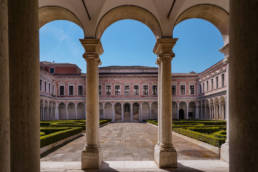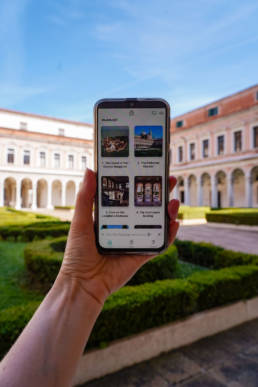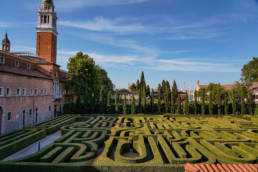On a recent trip to Venice, in search of new experiences, I headed to the island of San Giorgio Maggiore. Hidden in plain view of San Marco, and a stop on the regular traghetto line, the island is home to the Fondazione Giorgio Cini. Experiencing its architecture, history and immersive contemporary installations on the island of San Giorgio Maggiore in Venice can easily fill a whole day.

Palladio’s cloister at Fondazione Cini, Island of San Giorgio Maggiore, Venice. All photos by Alexandra Korey.
Fondazione Cini on the Island of San Giorgio Maggiore

The 10th-century Benedictine monastery on the island of San Giorgio Maggiore took several centuries of building and expansion, involving a few important names like Tintoretto and Veronese and the notable intervention of the architect Andrea Palladio. This spectacular and huge monastery fell into complete decline when Napoleon closed it in 1806 in the suppression of the religious orders that affected the whole country; photos showing what it was like 150 years afterwards are shocking.
A man named Vittorio Cini received permission to establish a foundation in the derelict buildings, dedicated to his son Giorgio, and he spent an unimaginable sum to restore the place. The Foundation today is home to a series of Institutes for advanced studies in the arts – art history, literature, music etc. – that organize conferences, studies and exhibitions.
What can you visit at Fondazione Cini? Art history lovers will be excited by the monumental cloister designed by Andrea Palladio, while anyone looking for an immersive contemporary art experience should visit the garden with the “chapels” designed for a recent biennale, and the newly opened maze. Access to these spaces is through self-guided group tours with timed entrances and everything is made clear with a smartphone app (which you can do on your device or use theirs). Florentine audioguide gurus D’Uva Workshop have turned these spaces into immersive audio experiences with award-winning music that quite literally transport you.

The Palladian Cloister on the Island of San Giorgio Maggiore

A few years ago, the only things to see on the Island of San Giorgio Maggiore were the church and the monumental cloister designed by Andrea Palladio, which, for an art geek like me would be plenty in and of itself. In fact, there’s a photo of me beaming with happiness in this courtyard when attending my very last scholarly art history conference before changing careers – the Renaissance Society of America 2010, which was hosted at Fondazione Cini.

Who was Andrea Palladio? He was a Venetian architect who published an important treatise, The Four Books of Architecture, towards the end of his career, summing up 30 years of practise and ensuring that his learnings would be passed down. You may know him from the Palladian villas of the Veneto, which are all UNESCO Heritage monuments.
The large cloister, or courtyard, at San Giorgio is part of an overhaul of the monastery that Palladio designed when appointed in 1560 as the architect in charge of building works. But the cloister was begun only in 1579, and Palladio died the next year. It took until 1615 to complete it.
Despite its impressive size, its breathtaking beauty derives, I think, from the way that it is immediately understandable to us – it’s huge, but it’s divided up into human-sized units. I can sit down between the columns and become part of it. How did Palladio pull this off? It probably had to do with the way that the architect studied and codified the orders of the columns, porticoes, and proportions. Height, width and numbers have all been carefully thought out. A nice trick is how he uses twin ionic columns, rather than a single column, to create a sense of depth and when you think about it, seem necessary to “hold up” a space of this size.
The garden with the Vatican Chapels
The Vatican Chapels was such a surprise! As an extremely informed and analytical museum-goer, and because I’m usually also photographing my visits at the same time, I’m rarely emotionally impacted by what I see. It’s a shame, really. The Vatican Chapels got to me, and that’s a great gift.
On occasion of the 2018 Venice Biennale di Architettura, the Vatican “pavilion” was hosted in the woods behind the Fondazione Cini, leaving behind an absolute treasure. Ten architects were asked to interpret the concept of “chapel”. Each one is truly original.
Ivy growing over a wooden structure, bordering on the shore, where the lagoon’s water laps against a wall. A shiny metal cross, suspended and in constant motion, a place for you to sit and reflect. A portable chapel that seems to contain divine light. I won’t tell you more, but urge you to go explore for yourself.
As you walk through these spaces, a voice guides you, briefly explaining the concept of each structure and luring you into a state of meditation with contemporary classical music. The beautiful soundtrack, with soaring strings, was written by composer Antonio Fresa and performed by the orchestra of Teatro La Fenice.
The maze: Borges Labyrinth
My visit to Fondazione Cini this summer was initially prompted by a new opening: the Borges Labyrinth was built in 2011, but the possibility to enter it, complete with a new commissioned soundtrack, inaugurated only in June 2021. A solo ballet was performed in the maze to the music that continues the collaboration with Antonio Fresa and the orchestra of Teatro La Fenice. The four tracks recount the metaphor of existence unfolding backwards from death to birth.
The visitor experience, with Bose headphones and a smartphone, cameras and other guests, is not exactly like that of the ballerina, though if you are able to create enough space between yourself and the other people, you can crank up the music and let it reach your soul. If you’re interested, the album with the music from the Labyrinth and Vatican Chapels is available for purchase on Amazon.com (affiliate link).

The maze spells out the word “Borges” with 3200 box hedges, paying homage to the Argentinian writer Jorge Luis Borges on the 25th anniversary of his death. His most famous works are about dreams, labyrinths, myths and philosophy, and he’s considered by some to be the founder of Magic Realism. Along with Joyce and Kafka he’s one of the writers (we’ve maybe never heard of!) who defined the twentieth century.
After the maze, you’ll get to peek into the Foundation’s peaceful modern library, designed only a decade ago. Located in what was originally the dormitory of the Benedictine monks, it has the peculiar characteristic of being punctuated by regular doors that would have provided access to the monks’ cells.

Practical information to visit the Fondazione Cini
All the spaces of the Fondazione Cini that I visited on the Island of San Giorgio Maggiore require advance booking for self-guided, timed-entrance tours that you can book on the website visitcini.com. Each itinerary takes one hour. If you’re visiting the woods with the Chapels during the summer months, my practical tip is to pack mosquito repellant, and also pack sunscreen for parts of the museum path that are not at all in the shade.
Check-in and audio-guide pickup take place at a central space that also houses what may be the island’s only bar and restaurant, the Cini Café. If you’re planning on doing multiple tours, consider booking a spot for lunch, where a modern menu is served up by a creative young chef who exalts local materials.
With thanks to Ilaria d’Uva of d’Uva Worshop, who manages Visit Cini, for the invitation to experience this Venetian island.
Sign up to receive future blog posts by email
Alexandra Korey
Alexandra Korey aka @arttrav on social media, is a Florence-based writer and digital consultant. Her blog, ArtTrav has been online since 2004.
Related Posts
September 11, 2023
An art historian’s approach to things to do in Naples, Italy
June 22, 2023
4 day trips from Palermo up the Tyrrhenian coast
September 20, 2021
A Day at the 2021 Venice Biennale di Architettura
August 5, 2021









